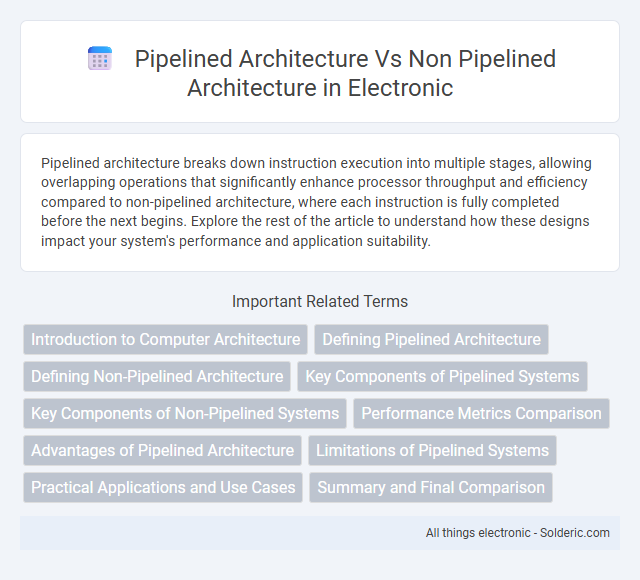Pipelined architecture breaks down instruction execution into multiple stages, allowing overlapping operations that significantly enhance processor throughput and efficiency compared to non-pipelined architecture, where each instruction is fully completed before the next begins. Explore the rest of the article to understand how these designs impact your system's performance and application suitability.
Comparison Table
| Aspect | Pipelined Architecture | Non-Pipelined Architecture |
|---|---|---|
| Definition | Processor design that divides instruction execution into sequential stages. | Processor executes instructions sequentially, one at a time. |
| Execution | Overlaps multiple instruction executions across different stages. | Executes one instruction fully before starting the next. |
| Throughput | High throughput due to concurrent instruction processing. | Lower throughput since processing is serial. |
| Latency | Latency per instruction remains similar but overall system response improves. | Higher latency as instructions are processed end-to-end. |
| Complexity | Higher hardware and control complexity due to hazards handling. | Simpler design with straightforward control logic. |
| Hazards | Prone to data, control, and structural hazards; requires hazard mitigation techniques. | No pipeline hazards; simpler data flow. |
| Performance | Improved performance and throughput for instruction execution. | Lower performance due to sequential instruction handling. |
| Resource Utilization | Efficient resource use with multiple pipeline stages active simultaneously. | Resources idle during parts of instruction processing. |
| Examples | Modern CPUs (e.g., Intel, AMD processors). | Simple microcontrollers, early processors. |
Introduction to Computer Architecture
Pipelined architecture enhances CPU performance by overlapping instruction execution, allowing multiple instructions to be processed simultaneously in different stages, whereas non-pipelined architecture executes instructions sequentially, completing one before starting the next. This design in pipelined processors significantly increases instruction throughput and utilizes hardware resources efficiently, reducing overall execution time. Your understanding of these architectures is crucial for optimizing computer performance and designing efficient systems.
Defining Pipelined Architecture
Pipelined architecture divides a processor's instruction cycle into discrete stages, allowing multiple instructions to overlap execution for enhanced throughput. Each stage processes a different instruction concurrently, significantly increasing overall processing speed compared to non-pipelined architectures. Non-pipelined architectures handle one instruction at a time, resulting in longer execution times and reduced performance efficiency.
Defining Non-Pipelined Architecture
Non-pipelined architecture processes one instruction at a time through all the CPU stages, resulting in slower overall execution due to idle hardware resources during each step. In this architecture, each instruction completes all stages--fetch, decode, execute, and write-back--before the next instruction begins, limiting instruction throughput. Understanding non-pipelined architecture helps you appreciate the efficiency gains achieved by pipelined systems that overlap multiple instruction stages simultaneously.
Key Components of Pipelined Systems
Pipelined architecture consists of key components such as instruction fetch, instruction decode, execute, memory access, and write-back stages that work concurrently to improve processing speed. Each stage acts as a separate pipeline segment, allowing multiple instructions to be processed simultaneously, unlike non-pipelined architecture where each instruction completes all stages before the next begins. Your system's performance depends on efficient synchronization and buffering between these pipeline stages to avoid hazards and maximize throughput.
Key Components of Non-Pipelined Systems
Non-pipelined architecture primarily consists of a single processing unit that executes one instruction at a time through sequential stages: instruction fetch, decode, execute, memory access, and write-back. Key components include a control unit to direct operations, an arithmetic logic unit (ALU) for computation, registers for temporary data storage, and a memory unit for instruction and data retrieval. The absence of overlapping instruction execution limits throughput but simplifies hardware design and reduces control complexity.
Performance Metrics Comparison
Pipelined architecture significantly improves instruction throughput by enabling overlapping execution stages, resulting in higher performance metrics such as CPI (Cycles Per Instruction) reduction and increased processor utilization. Non-pipelined architecture processes instructions sequentially, leading to longer execution times and lower instruction throughput, as each instruction must complete before the next begins. Benchmark analyses reveal that pipelined processors achieve better clock cycle efficiency and enhanced instruction-level parallelism, directly impacting overall system performance.
Advantages of Pipelined Architecture
Pipelined architecture improves CPU performance by executing multiple instructions simultaneously through overlapping stages, significantly increasing instruction throughput compared to non-pipelined designs. This architecture reduces the overall instruction execution time, enabling faster processing speeds and enhanced system efficiency. Pipelining also optimizes resource utilization by keeping different processing units busy at all times, minimizing idle CPU cycles.
Limitations of Pipelined Systems
Pipelined architecture improves instruction throughput by overlapping stages, but it faces limitations such as pipeline hazards, including data, control, and structural hazards, which cause stalls and reduce efficiency. The complexity of handling hazards increases design difficulty, requiring techniques like forwarding and branch prediction that may not always be accurate. Your system's performance can degrade due to pipeline flushes and bubbles introduced by mispredictions or dependencies, limiting the theoretical speedup gained from pipelining.
Practical Applications and Use Cases
Pipelined architecture enhances processing speed and efficiency, making it ideal for high-performance computing tasks such as gaming, multimedia processing, and real-time data analysis. Non-pipelined architecture is often preferred in simpler control systems and embedded applications where predictability and lower power consumption are crucial. Understanding your system's requirements helps determine which architecture supports optimal performance and resource management.
Summary and Final Comparison
Pipelined architecture enhances CPU performance by overlapping instruction execution through multiple pipeline stages, significantly increasing instruction throughput compared to non-pipelined architecture, which processes one instruction at a time. While pipelined processors achieve higher clock speeds and better resource utilization, non-pipelined designs offer simpler control logic and lower latency per instruction in specific contexts. The final comparison reveals that pipelining is advantageous for complex, high-performance CPUs demanding parallel instruction handling, whereas non-pipelined architectures can be preferable in low-complexity or real-time systems prioritizing minimal overhead.
pipelined architecture vs non pipelined architecture Infographic

 solderic.com
solderic.com